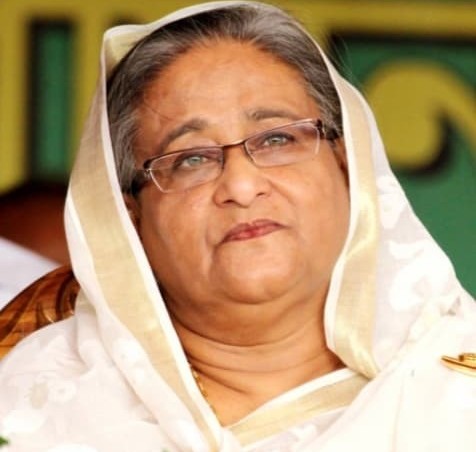When Sheikh Hasina retained power through yet another stage-managed election in January 2024 and continued as prime minister, she might have believed her grip on power was unshakable.
Her political opponents were crippled, dissent silenced, and international partners—though critical—continued business as usual.
For her loyalists and enablers in the bureaucracy, business elite, and foreign missions, the dust of a controversial vote seemed to have settled. But storms do not wait for permission—they rise from the cracks of public resentment. The storm sparked by students, soon joined by the masses, ultimately swept her from power.
Legacy rooted in blood
As the eldest daughter of Sheikh Mujibur Rahman, the country’s founding leader, Hasina’s return from exile in 1981 to lead the Awami League marked an attempt to rebuild from ashes. The assassination of her father and most of her family in 1975 had left her a symbolic bridge between a bloodied past and democratic aspirations. Over time, she rose from a party figurehead to a seasoned opposition leader.
In 1996, she led her party to victory, becoming prime minister for the first time by defeating her arch-rival, the incumbent BNP government led by Khaleda Zia. That tenure saw modest economic reforms, the Ganges Water Treaty with India, and the signing of the Chittagong Hill Tracts Peace Accord. It evoked a sense of balance between national reconciliation and pragmatic statecraft.
But it was her return in 2009—after a decisive electoral win—that transformed Hasina from a national leader into a near-absolute ruler.
From democratic leader to authoritarian ruler
Following two years of military-backed emergency rule (2007–08), Hasina’s landslide victory in 2008 seemed to restore democracy. There was hope, initially. Her early days promised development, digital connectivity, and anti-militancy efforts. Trials of war criminals, many from the Islamist Jamaat-e-Islami, earned her widespread public support.
However, over time, her governance shifted from democratic consolidation to autocratic control. Political institutions weakened under executive pressure, and the judiciary grew increasingly pliant. Media freedoms were curtailed through draconian digital laws, and space for dissent narrowed rapidly.
Notably, her government unleashed a reign of terror against political opponents, particularly targeting BNP and Jamaat-e-Islami. Thousands of activists were arrested on dubious charges. Many were victims of extrajudicial killings or enforced disappearances—a term that became tragically common under Hasina’s rule.
The elite police unit, Rapid Action Battalion (RAB), once praised for counter-terrorism operations, became a feared tool of political repression. The abuse was so widespread that in 2021, the United States imposed sanctions on RAB and several top officials for gross human rights violations.
Power without consent
Despite plummeting popularity, Hasina clung to power through controversial elections in 2014 and 2018—both marred by widespread irregularities, intimidation, and ballot-stuffing. The opposition was either barred from contesting or rendered powerless. The pattern repeated in 2024, with a one-sided election boycotted by most credible opponents.
This cycle of power without consent fuelled a growing legitimacy crisis. While Hasina projected an image of stability and development—pointing to roads, bridges, and GDP growth—the public, especially the youth, saw rising unemployment, corruption, and the suffocating grip of authoritarianism.
The uprising and the collapse
What began as a small campus protest over job quotas in July 2024 quickly snowballed into a nationwide uprising. Underestimating the momentum, Hasina responded with her usual iron-fisted tactics. Police, intelligence agencies, and plainclothes forces opened fire on protesters, killing hundreds and injuring thousands—with ruling party members aiding the violence.
Rather than quelling unrest, the brutality inflamed it. Citizens poured into the streets, and parts of the security apparatus began to defect. The military, notably, refused to fire on civilians.
As state institutions faltered and international pressure mounted, Hasina’s grip weakened. On 5 August, reportedly unable to regain control, she fled to India—seeking refuge there for the second time in 43 years.
Legacy tainted by blood
Hasina’s political journey is a tragedy of transformation. From the daughter of a martyred father, and the nation’s second female prime minister, to a ruler who ordered the shooting of unarmed youths, her arc reflects how power corrodes when left unchecked.
Even her legacy of infrastructure, economic growth, and regional diplomacy is now overshadowed by the July–August bloodshed. For many, her rule serves as a case study in how democratic mandates can be manipulated into authoritarian regimes under the guise of development.
As the interim government struggles to restore peace and stability, the lesson from Hasina’s downfall remains clear: power without accountability may endure for a time, but eventually, the people reclaim their voice. Once the face of a post-military democratic future, her exit stands as a warning of what unchecked power can destroy.
Now facing charges of crimes against humanity, Sheikh Hasina may evade justice—but she cannot erase the brutal and bloody legacy she has left behind.


